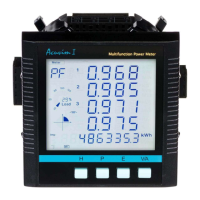77
This function is controlled by the lower 8 bits of the 16-bit register and each
bit is corresponding to a pair. “1” means this function is enabled and “0” means
disabled.
“Alarming output to DO1 setting”: When “Digital output mode” is set to “1”,
DO1 can be used as alarming output. A 16-bit register is used to perform this
function, its bit0~bit15 correspond to the 1
st
~16
th
group respectively. When
the related I/O module is connected and is under alarming mode, and if the
corresponding bit is set to 1 and the alarming condition is met, alarm signal will
be sent to DO1. DO1 will be turned o when all alarms correspond to DO1 are
cleared. If related bit is set to 0, that alarm channel will not issue alarm signal to
DO1. DO2~DO4 work in the same manner DO1.
After completing the setup steps correctly, alarming function can be used.
3. Setting Example
Here is an example showing how to apply the logic "AND" function for a pair of
alarm channels.
The conditions are as follows: I1 greater than 180A, delay 5s for the 1
st
alarm
channel; U1 less than 9980V, delay 10s for the 2
nd
alarm channel. No alarm
signals will be sent to outputs. The CT primary value of I1 is 200A, and CT2 is
5A. The PT ratio for U1 is 10000:100. The following shows how all the related
registers are to be set.
Settings of rst group:
“Parameter code (104EH)” is set to 9, which stands for I1.
“Comparison mode (104FH)” is set to 1, which stands for "greater than".
“Setpoint value (1050H)” is set to 4500, according to the relationship between
actual value and communication value (I=Rx * (CT1/CT2) /1000).

